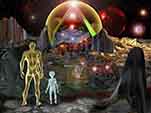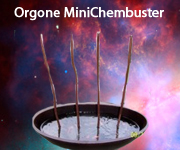This is from Dr. Robert Cathcart's site:
http://www.orthomed.com/polio.htm
=======
July, 1949 SOUTHERN MEDICINE & SURGERY 209
The Treatment of Poliomyelitis and Other Virus
Diseases with Vitamin C
Fred R. Klenner, M.D., Reidsville, North Carolina
IN A PREVIOUS REPORT dealing with the antagonistic properties of
ascorbic acid to the virus of atypical pneumonia, mention was made of
the fact that other types of virus infections had responded favorably
to vitamin C. This paper is to present these findings as well as the
results of subsequent studies on the virus of poliomyelitis, the
viruses causing measles, mumps, chickenpox, herpes zoster, herpes
simplex and influenza. Further studies with the virus of atypical
pneumonia will also be discussed.
These observations of the action of ascorbic acid on virus diseases
were made independently of any knowledge of previous studies using
vitamin C on virus pathology, except for the negative report of Sabin
after treating Rhesus monkeys experimentally infected with the
poliomyelitis virus. A review of the literature in preparation of this
paper, however, presented an almost unbelievable record of such
studies. The years of labor in animal experimentation, the cost in
human effort and in "grants," and the volumes written, make it
difficult to understand how so many investigators could have failed in
comprehending the one thing that would have given positive results a
decade ago. This one thing was the size of the dose of vitamin C
employed and the frequency of its administration. In all fairness it
must be said that Jungeblut noted on several occasions that he
attributed his failure of results to the possibility that the strength
of his injectable "C" was inadequate. It was he who unequivocally said
that ''vitamin C can truthfully be designated as the antitoxic and
antiviral vitamin."
In developing this paper it was felt that, since all virus infections
were more or less akin, only one of this family would be considered in
detail. Poliomyelitis, because of its prevalence and the seriousness of
the problem it presents, was chosen as the disease to be so treated.
Poliomyelitis is in most instances an acute febrile disease of sudden
onset, with symptoms of a systemic infection which either abruptly
abort or develop to hyperesthesia, asymmetry of reflexes and flaccid
paralysis or palsies of muscle groups. It affects individuals of all
ages, but mainly children, as do more common childhood diseases to
which class it most likely belongs. Only slight contact between the
carrier of the virus and the susceptible person suffices in some cases
for the transfer of the causative organism. In this respect and also in
that the virus can be demonstrated in the nasal washings as early as
six days before onset of symptoms, poliomyelitis resembles measles. We
never have an epidemic of poliomyelitis preceding an epidemic of
measles; the opposite is frequently true. This grouping of the virus
organisms is too often repeated not .to carry some significance. For
example, atypical pneumonia and influenza are caused by closely allied
viruses; so are chickenpox, herpes zoster and herpes simplex; so are
measles, mumps and poliomyelitis. The incubation period depends on the
mode of entry. In experimental animals. Fraser and others showed that
the average was 6.6 days with intracerebral inoculation and ten days
when the intravenous route was used. Howitt mentions that the virus
reaches the nervous system sooner after intranasal than after
intravenous instillations. Transmission (Brodie, 1934) is by means of
droplets from the mucous membrane of the upper respiratory tract.
Infection by means of raw milk, human feces and house flies is highly
improbable.
The research of Flexner, Dark and Amoss in 1914 proved that
poliomyelitis is a disease of the entire nervous system, that the
sensory ganglia are the seats of early and profound histological
changes. The disease is significant mainly for the paralysis produced
through injury to the motor neurons of the spinal cord and brain. This
is caused by a special affinity of the virus for a certain type of
nerve tissue. Experiments show the cerebral cortex to be the most
unsatisfactory site for growth, that large amounts of the virus placed
in this area are apt to disappear in a short time. Observations in
monkeys and in man show that the anterior horn cells, particularly
those of the lumbar cord, are the most favorable sites for
proliferation of the virus.
In all clinically ill patients the virus eventually travels in the
course of its invasion by several channels. The virus can make a direct
assault through the olfactory bulb, to the brain, medulla and spinal
cord. The virus can enter the blood stream directly or through the
lymph channels. Following damage to the natural protective barrier, the
choroid plexus, it can make its way to the central nervous system, or
it can be excreted back onto the nasal mucous membrane where it will
pick up the direct route of the olfactory bulb.
Clark, Turner and Reynolds (1926, 1927, 1929) concluded that the virus
chiefly travels by the direct route to the brain. Lennette and Hudson (
1935) confirmed this theory and reported their studies indicating that
human infection is chiefly through the nasopharynx. Brodi and others
showed that by section of the olfactory tracts in monkeys infection by
the direct route was prevented. It is of more than mere academic
interest that while the nasal mucosa of the monkey contains branches of
the 5th and 7th cranial nerves and that in addition, since the virus
can readily gravitate from the nasopharynx to the tonsil bed with its
nerve supply, if the olfactory tracts are cut no infection will occur.
The most likely explanation is that the olfactory is non-medullated,
the neurons lie in the nasal mucosa and are thus exposed to the virus.
The sciatic nerve (Brodi) will transport the virus only when it has
been injured, suggesting that lack of myelin may render the healthy
olfactory nerve vulnerable to the virus.
The most important of the secondary routes of infection is by the
excretion of the virus from the blood stream onto the nasal mucosa.
Lennette and Hudson (1934, 1935) demonstrated in monkeys that by
sectioning the olfactory tracts and then inoculating by the intravenous
route with the virus of poliomyelitis, they could prevent infection.
This would fit in with the work of Jungeblut and others that the spread
of the virus through the central nervous system is along nerve tracts,
rather than by means of the cerebrospinal fluid, the infection to
become manifest when the first cell group is reached, and by relays of
fibers, reaches the mid-brain. Here numerous fiber-paths run in all
directions and the virus is carried by both motor and sensory axons,
causing disease at many levels of the brain and cord.
Since there is always a period of septicemia in the first few days of
poliomyelitis, it might be that this is the all-important route and
that the virus is grown on a living tissue, the blood, and then is
deposited out on the surface of the olfactory bulb. From this we
conclude that the time to destroy the virus is during this incubation
period which varies more with virulence and power of multiplication
than with size of initial dose.
The second flanking maneuver of importance is through the choroid
plexus. It is the function of the choroid plexus and the pial lymphatic
vessels to exclude the virus present in the blood from the nervous
system. Once these protective structures are injured, however, the
exclusion ceases and infection can follow readily. Changes in the
structure or function of the meningeal choroid plexus complex, too
slight to be detected in the cerebrospinal fluid or as morphological
alterations, materially diminish its protective power. Flexner and
Amoss injected large doses of the virus intravenously, then tested the
cerebrospinal fluid and found no virus after the first 48 hours; virus
in small amounts at the end of 72 hours; after 96 hours evidence of
free access to this system. The virus was still present 19 days later
when paralysis was beginning.
Poliomyelitis in man is always more severe if exercise is taken at time
of the infection. Here one must consider the factor of filtration of
the virus through the choroid plexus as being increased due to the
elevation of the vascular bed pressure. Also, that, by the acceleration
of the blood flow caused by greater oxygen demand in physical effort, a
marked increase in the percentage of the virus deposited on the nasal
mucosa would result.
We must agree with Fairbrother and Hurst that too little consideration
has been given to the pathology of the nervous system and in particular
to the drainage of the tissue fluids. These men confirmed the earlier
work of Schroder, who stressed that the normal flow of these fluids is
along the perivascular spaces from the center of the cord outward, and
that any inflammatory exudate occupying these spaces must be swept into
the pial meshes; further that meningeal infiltration may seem nothing
more than a drainage of cells from the interior of the cord.
Fairbrother and Hurst found that meningeal infiltration does not occur
in monkeys until the perivascular infiltration beginning in the deeper
vessels reaches the surface.
The presence of the filterable microorganism or virus of poliomyelitis
upon the mucous membrane of the nose and throat does not necessarily
lead to infection. It may give rise to a class of healthy carriers who
are themselves immune. Amoss and Taylor found a secretion of the mucous
membrane capable of neutralizing or inactivating the virus, this
property absent altogether from the secretions of some persons, in
those of others present at one time and not at another. It is probable
that in actively immune animals the passage of the neutralizing
substance from the blood into the cerebrospinal fluid would continue as
long as the inflammation present in the meninges rendered the
structures easily permeable to the protein constituents of the blood.
This secretion X could not have the properties of a true antibody. The
virus of poliomyelitis is intracellular from the time it invades the
terminal cells of the olfactory system until the end of the disease,
except when crossing the synaptic junctions between cells. This
explains why the virus cannot be neutralized by antibodies in the
serum. Further protection is afforded the virus by the functional
barrier between the circulating blood and the central nervous system.
Since immunization against poliomyelitis comparable to that against
other bacterial diseases is still a matter of the future, it suggested
itself that some antibiotic could be found that would destroy this
scourge while in the phase of blood-stream invasion. Sabin's negative
report on the value of ascorbic acid on the poliomyelitis virus stopped
Jungeblut's work, but we were cognizant of its dramatic effect on the
virus causing atypical pneumonia, and so kept up hope. These results
were so consistently positive that we did not hesitate to try its
effectiveness against all type of virus infections. The frequent
administration of massive doses of vitamin C was so encouraging in the
early days of the 1948 epidemic of poliomyelitis that a review of the
literature was begun. Heaslip, in the Australian Journal of
Experimental Biology & Medicine reported a mean urinary output of
vitamin C under a load test of 19.9 per cent in 60 poliomyelitis cases,
as contrasted with a mean figure of 44.3 per cent in 45 healthy
contacts. This was suggestive of some relationship between the degree
of vitamin C saturation and the infectious and non-infectious state. He
was also able to show a correlation between the severity of the attack
and the level of urinary excretion of the vitamin. This would indicate
that a deficiency of vitamin C in the diet predisposed to infection and
to severity of attack. Sabin reported no appreciable difference in
infectivity of poliomyelitis in monkeys with much or no vitamin C in
the diet. Many others, however, have reported that a "deficient vitamin
C nutrition increases susceptibility to infection," and many others
that animals dying from the effects of the poliomyelitis virus show a
reduction of vitamin C in the tissues. Heaslip found a definite
relationship between the severity of the infection and the level of
vitamin C nutrition. It is consistent with accepted physiological
action of vitamin C to expect and anti-edema effect in any given
affected area. It is worthy of note that bacterial toxins can cause
losses of from 50 to 85 per cent of the vitamin C normally contained in
the adrenals. Jungeblut's investigations seemed to justify the
conclusion that vitamin C was the "antibiotic" that would destroy the
virus organism. He stated that the prophylactic and therapeutic
administration of synthetic or natural vitamin C had given evidence of
having distinct therapeutic properties in experimental poliomyelitis,
and that the proper injection dose was directly proportional to the
speed of the infection and the stage at which the process had arrived.
Jungeblut stated in 1937 that the parental administration of natural
vitamin C during its incubation period of poliomyelitis in monkeys is
always followed by a distinct change in the severity of the disease;
that after the fifth day of the disease distinctly larger doses are
required. He realized, at that early date, that for a fast progressing
infection such as results from the R. M. V. strain, very large
doses-400 mg. crystalline C maximum in a 24-hour period-of vitamin C
would be required; for the Aycock virus with its slower infection
potential small amounts of the vitamin would suffice. Even with almost
infinitesimal amounts-100 mg. ascorbic acid for each 24-hour period-he
was able to demonstrate that the non-paralytic survivors in one series
was six times as great as in the controls. In our work we shall speak
of six, ten and 20 thousand mg. in a similar time period.
Harde et al. reported that diphtheria toxin is inactivated by vitamin C
in vitro and to a lesser extent in vivo. I have confirmed this finding,
indeed extended it. Diphtheria can be cured in man by the
administration of massive frequent doses of hexuronic acid (vitamin C)
given intravenously and/or intramuscularly. To the synthetic drug, by
mouth, there is little response, even when 1000 to 2000 mg. is used
every two hours. This cure in diphtheria is brought about in half the
time required to remove the membrane and give negative smears by
antitoxin. This membrane is removed by lysis when "C" is given, rather
than by sloughing as results with the use of the antitoxin. An
advantage of this form of therapy is that the danger of serum reaction
is eliminated. The only disadvantage of the ascorbic acid therapy is
the inconvenience of the multiple injections. This concept of the
action of vitamin C against certain toxins has led to treating other
diseases producing exotoxins. For years it has been our knowledge that
vitamin C in 500 to 1000 mg. doses injected I. M. would cure bacillary
dysentery of the Shiga type. Children having 10 to 15 bloody stools per
day have cleared in 48 hours under this schedule while at the same time
reverting to normal feedings. This dual action of vitamin C against
certain toxins and the virus organism becomes more intelligible with
the work of Kligler, Warburg and others who believed that the
detoxification effected by hexuronic acid is brought about by a direct
combination of the vitamin with the toxin or virus, this followed by
oxidation of the new compound which destroys both the virus or toxin
and the vitamin. Borsook et al. decided that the main chemical action
of ascorbic acid is as a powerful reducing agent, and the virus causing
poliomyelitis is known to be susceptible to the oxidizing action of
various agents. It is in point here to remark that vitamin C is an
integral part of the oxidation-reduction system of the body, thus
playing a definite part in natural resistance.
In the poliomyelitis epidemic in North Carolina in 1948, 60 cases of
this disease came under our care. These patients presented all or
almost all of these signs and symptoms: Fever of 101 to 104.6°,
headache, pain at the back of the eyes, conjunctivitis, scarlet throat;
pain between the shoulders, the back of the neck, one or more
extremity, the lumbar back; nausea, vomiting and constipation. In I5 of
these cases the diagnosis was confirmed by lumbar puncture; the cell
count ranging from 33 to 125. Eight had been in contact with a proven
case; two of this group received spinal taps. Examination of the spinal
fluid was not carried out in others for the reasons: (1) Flexner and
Amoss had warned that "simple lumbar puncture attended with even very
slight hemorrhage opens the way for the passage of the virus from the
blood into the central nervous system and thus promotes infection." (2)
A patient presenting all or almost all of the above signs and symptoms
during an epidemic of poliomyelitis must be considered infected with
this virus. (3) Routine lumbar puncture would have made it obligatory
to report each case as diagnosed to the health authorities. This would
have deprived myself of valuable clinical material and the patients of
most valuable therapy, since they would have been removed to a
receiving center in a nearby town.
The treatment employed was vitamin C in massive doses. It was given
like any other antibiotic every two to four hours. The initial dose was
1000 to 2000 mg., depending on age. Children up to four years received
the injections intramuscularly. Since laboratory facilitates for whole
blood and urine determinations of the concentration of vitamin C were
not available, the temperature curve was adopted as the guide for
additional medication. The rectal temperature was recorded every two
hours. No temperature response after the second hour was taken to
indicate the second 1000 or 2000 mg. If there was a drop in fever after
two hours, two more hours was allowed before the second dose. This
schedule was followed for 24 hours. After this time the fever was
consistently down, so the drug was given 1000 to 2000 mg. every six
hours for the next 48 hours. All patients were clinically well after 72
hours. After three patients had a relapse the drug was continued for at
least 48 hours longer-1000 to 2000 mg. every eight to 12 hours. Where
spinal taps were performed, it was the rule to find a reversion of the
fluid to normal after the second day of treatment.
For patients treated in the home the dose schedule was 2000 mg. by
needle every six hours, supplemented by 1000 to 2000 mg. every two
hours by mouth. The tablet was crushed and dissolved in fruit juice.
All of the natural "C" in fruit juice is taken up by the body; this
made us expect catalytic action from this medium. Ruin, 20 mg., was
used with vitamin C by mouth in a few cases, instead of the fruit
juice. Hawley and others have shown that vitamin C taken by mouth will
show its peak of excretion in the urine in from four to six hours.
Intravenous administration produces this peak in from one to three
hours. By this route however, the concentration in the blood is raised
so suddenly that a transitory overflow into the urine results before
the tissues are saturated. Some authorities suggest that the
subcutaneous method is the most conservative in terms of vitamin C loss
but this factor is overwhelmingly neutralized by the factor of pain
inflicted.
Two patients in this series of 60 regurgitated fluid through the nose.
This was interpreted as representing the dangerous bulbar type. For a
patient in this category postural drainage, oxygen administration, in
some cases tracheotomy, needs to be instituted, until the vitamin C has
had sufficient time to work-in our experience 36 hours. Failure to
recognize this factor might sacrifice the chance of recovery. With
these precautions taken, every patient of this series recovered
uneventfully within three to five days.
In the treatment of other types of virus infections the same "fluid"
dose schedule was adopted. In herpes zoster 2000 to 3000 mg. of vitamin
C was given every 12 hours, this supplemented by 3 000 mg. in fruit
juice by mouth every two hours. Eight cases were treated in this
series, all of adults. Seven experienced cessation of pain within two
hours of the first injection and remained so without the use of any
other analgesic medication. Seven of these cases showed drying of the
vesicles within 24 hours and were clear of lesions within 72 hours.
They received from five to seven injections. One patient; a diabetic,
stated that she was always conscious of an uncomfortable feeling, but
that it was not an actual pain. Although nine-tenths of the vesicles
cleared in the usual 72-hour period, she was given 14 injections, the
last seven of only 1000 mg. This extra therapy was given because of a
small ulceration, an inch in diameter, secondarily infected by rupture
of the vesicles by a corset stave prior to the first visit. Vitamin C
apparently had no effect on this lesion, which was healed in two weeks
under compound tincture of benzoin locally and penicillin and
sulfadiazine by mouth. (The patient objected to taking penicillin by
needle.) One of the patients, a man of 65, came to the office doubled
up with abdominal pain and with a history of having taken opiates for
the preceding 36 hours. He gave the impression of having an acute
surgical condition. A massive array of vesicles extended from the
dorsal nerve roots to the umbilicus, a hand's breadth wide. He was
given 3000 mg. of vitamin C intravenously and directed to return to the
office in four to five hours. It was difficult to convince him that his
abdominal pain was the result of his having "shingles." He returned in
four hours completely free of pain. He was given an additional 2000 mg.
of vitamin C, and following the schedule given above he recovered
completely in three days.
In herpes simplex it is important to continue the treatment for at
least 72 hours. We have seen "fever blisters" that appeared healed
after two injections recur when therapy was discontinued after 24
hours. Vitamin C in a strength of 1000 mg. per 10 c.c. of buffered
solution gave no response when applied locally. This was true no matter
how often the applications were made. In several cases 10 mg. of
riboflavin by mouth t.i.d. in conjunction with the vitamin C injections
appeared to cause faster healing.
Chickenpox gave equally good response, the vesicles responding in the
same manner as did those of herpes. These vesicles were crusted after
the first 24 hours, and the patient well in three to four cays. We
interpreted this similarity of response in these three diseases to
suggest that the viruses responsible were closely related to one
another.
Many cases of influenza were treated with vitamin C. The size of the
dose and the number of Injections required were in direct proportion to
the fever curve and to the duration of the illness. Forcing of fruit
juice was always recommended, because of the frequency and ease of
reinfection during certain periods of the year.
The response of virus encephalitis to ascorbic acid therapy was
dramatic. Six cases of virus encephalitis were treated and cured with
vitamin C injections. Two cases were associated with virus pneumonia;
one followed chickenpox, one mumps, one measles and one a combination
of measles and mumps. In the case that followed the measles-mumps
complex, definite evidence was found to confirm the belief that
massive, frequent injections are necessary in treating virus infections
with vitamin C. This lad of eight years was first seen with a
temperature of 104°. He was lethargic, very irritable when molested.
His mother said he had gradually developed his present clinical picture
over the preceding four or five days. His first symptom was anorexia
which became complete 36 hours before his first examination. He next
complained of a generalized headache, later be became stuporous.
Although very athletic and active, he voluntarily took to his bed. He
was given 2000 mg. of vitamin C intravenously and allowed to return
home because there were no available hospital accommodations. His
mother was asked to make an hourly memorandum of his conduct until his
visit set for the following day. Seen 18 hours after the initial
injection of vitamin C, the memorandum revealed a quick response to the
antibiotic-after two hours he asked for food and ate a hearty supper,
then played about the house as usual and then, for .several hours, he
appeared to have completely recovered. Six hours following the initial
injection, he began to revert to the condition of his first visit. When
seen the second time temperature was 101.6°, he was sleepy but he would
respond to questions. The rude irritability shown prior to the first
injection was strikingly absent. A second injection of 2000 mg. vitamin
C was given intravenously and 1000 mg. of "C" prescribed every two
hours by mouth. The next day he was fever and symptom-free. As a
precautionary measure a third 2000 mg. was given with direction to
continue the drug by mouth for at least 48 hours. He has remained well
since. A lad of 12 years had generalized headache a week after having
mumps, this followed by malaise, and in 12 hours a lethargic state and
a fever of 105°. Admitted to hospital he was given 2000 mg. of vitamin
C then, and 1000 mg. every two hours. Following the third injection he
was sitting up in bed, laughing, talking, begging for food and
completely without pain. He was discharged 24 hours following admission
clinically well. Since relapses do occur if the drug is discontinued
too soon, he was given 2000 mg. of vitamin C every 12 hours for two
additional days.
The use of vitamin C in measles proved to be a medical curiosity.
During an epidemic vitamin C was used prophylactically and all those
who received as much as 1000 mg. every six hours, by vein or muscle,
were protected from the virus. Given by mouth, 1000 mg. in fruit juice
every two hours was not protective unless it was given around the
clock. It was further found that 1000 mg. by mouth, four to six times
each day, would modify the attack; with the appearance of Koplik's
spots and fever, if the administration was increased to 12 doses each
24 hours, all signs and symptoms would disappear in 48 hours. If the
drug was discontinued or reduced to three or four doses each 24 hours
following the disappearance of Koplik's spots, within another 48-hour
period the fever, the conjunctivitis and Koplik's spots would be back.
It was our privilege to observe this picture over and over in two
little volunteer girls for 30 days. These "research helpers" were my
own little daughters. The measles virus was eventually destroyed in
this instance by continuing 12,000 mg. by mouth each 24 hours for four
days. We interpreted this result to indicate that on withdrawing the
drug with the cessation of signs and symptoms, a small quantity of the
virus remained, which after another incubation period produced anew the
first stage of measles; when the drug was continued beyond the clearing
stage the virus was destroyed in toto. No case of post-measles
bronchopneumonia was seen. The "measles-cough" of measles bronchitis
was over with after three or four 1000 mg. injections of "C" at 6-hour
intervals. This was true even when other medications well above the
calculated dose range for cough had had no effect. Whenever a patient
presented a mixed-virus infection, such as receding mumps and
developing measles, it was found that double the calculated dose of
vitamin C was necessary to obtain the usual results.
Of mumps, 33 cases were treated with ascorbic acid. When vitamin C was
given at the peak of the infection the fever was gone within 24 hours,
the pain within 36 hours, the swelling in 48 to 72 hours. Two cases
were complicated with orchitis. A young man of 23 years developed
bilateral orchitis one Friday morning, by seven o'clock that night he
was in severe pain, had a fever of 105" and was nursing testicles the
size of tennis balls. Vitamin C was started at this time-1000 mg. every
two hours, intravenously. The pain began to subside following the first
injection and ceased in 12 hours. There was no fever after 36 hours.
The patient was out of bed feeling his old self after 60 hours. He had
received 25,000 mg. of "C" in this 60-hour period. An experiment
involving three cousins: One, a boy of seven, had the old routine of
bed rest, aspirin, and warm camphor oil applications and iodex to the
swollen glands. This child had a rough time for a week. A second boy,
aged 11, was allowed to develop mumps to the point of maximum swelling
without any therapy, then given vitamin C, 1000 mg. intramuscularly,
every two to four hours. This lad was entirely well in 48 hours. To the
third patient, a girl of 9, vitamin C was given on the up curve when
the swellings were 60 per cent of the expected, and the temperature
recorded at 102.3°. The dose was 1000 mg. of vitamin C given
intravenously every four hours. This child was well and remained so
from the third day of treatment.
Further studies on virus pneumonia showed that the clinical response
was better when vitamin C was given to these patients according to the
dose schedule outlined for poliomyelitis. Where pneumonitis was
demonstrated, the clearing of the chest film was parallel with the
clinical recovery. In cases of consolidation of entire lobes the x-ray
clearing lagged days behind the clinical response. In these cases 1000
mg. of "C" should be given every 12 hours for at least a week after the
patient is apparently well. There was no change in the results as given
in a previous paper; the patients were well in the third day of
treatment.
In using vitamin C as an antibiotic no factor of toxicity need be
considered. To confirm this observation 200 consecutive hospital
patients were given ascorbic acid, 500 to 1000 mg. every four to six
hours, for five to ten days. One volunteer received 100,000 mg. in a
12-day period. It must be remembered that 90 per cent of these patients
did not have a virus infection to assist in destroying the vitamin. In
no instance did examination of the blood or urine indicate any toxic
reaction, and at no time were there any clinical manifestations of a
reaction to the drug. When vitamin C was given by mouth one per cent of
these patients vomited shortly after taking the drug. In half of these
cases the vomiting was controlled by increasing the carbohydrate
content of the mixture. This reaction was not interpreted as
representing a toxic manifestation; rather it was thought to be due to
a hypersensitive gastric mucosa. The dose was reduced from 1000 to 100
mg. in young children showing this complex; vomiting occurred as
before. However, in these same patients administration of massive,
frequent doses of vitamin C by needle affected a cure of the infection
without causing vomiting.
From a review of the literature one can safely state that in all
instances of experimental work with ascorbic acid on the virus organism
the amount of virus used was beyond the range of the administered dose
of this vitamin. No one would expect to relieve kidney colic with a
five-grain aspirin tablet; by the same logic we cannot hope to destroy
the virus organism with doses of vitamin C of 10 to 400 mg. The results
which we have reported in virus diseases using vitamin C as the
antibiotic may seem fantastic. These results, however, are no different
from the results we see when administering the sulfa, or the
mold-derived drugs against many other kinds of infections. In these
latter instances we expect and usually get 48- to 72-hour cures; it is
laying no claim to miracle-working then, when we say that many virus
infections can be cleared within a similar time limit.






































